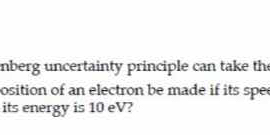How accurately can the position of an electron be determined if its speed is known and its energy is 10 eV, according to the Heisenberg uncertainty principle?

Understand the Problem
The question is asking how accurately the position of an electron can be determined based on its speed and energy, using the Heisenberg uncertainty principle.
Answer
The uncertainty in position is approximately $\Delta x \approx 1.2 \times 10^{-10} \text{ m}$.
Answer for screen readers
The uncertainty in position $\Delta x$ can be calculated, which is approximately:
$$ \Delta x \approx 1.2 \times 10^{-10} \text{ m} $$
Steps to Solve
- Recall the Heisenberg Uncertainty Principle
The Heisenberg uncertainty principle states that the uncertainty in position $\Delta x$ and the uncertainty in momentum $\Delta p$ of a particle are related by the equation:
$$ \Delta x \Delta p \geq \frac{\hbar}{2} $$
where $\hbar$ (reduced Planck's constant) is approximately $1.055 \times 10^{-34} \text{ Js}$.
- Calculate the momentum uncertainty
The momentum $p$ is given by $p = mv$, where $m$ is the mass of the electron ($m \approx 9.11 \times 10^{-31} \text{ kg}$) and $v$ is its speed. The kinetic energy $K.E.$ can also be expressed as:
$$ K.E. = \frac{1}{2}mv^2 $$
Given the energy $K.E. = 10 \text{ eV}$, we convert it to Joules:
$$ 10 \text{ eV} = 10 \times 1.6 \times 10^{-19} \text{ J} = 1.6 \times 10^{-18} \text{ J} $$
Rearranging to find $v$:
$$ v = \sqrt{\frac{2 K.E.}{m}} = \sqrt{\frac{2 \times 1.6 \times 10^{-18}}{9.11 \times 10^{-31}}} $$
Calculating $v$ gives the speed of the electron.
- Determine the uncertainty in momentum
Using the speed obtained:
$$ p = mv $$
The uncertainty in momentum $\Delta p$ is approximated as:
$$ \Delta p \approx m \Delta v $$
Since we assume small velocities for the uncertainty, we will consider $\Delta v$ as a small fraction of $v$.
- Find the uncertainty in position
Now, insert $\Delta p$ back into the Heisenberg Uncertainty Principle equation:
$$ \Delta x \geq \frac{\hbar}{2 \Delta p} $$
Given that $\Delta p = m \Delta v$, we can express the position uncertainty as:
$$ \Delta x \geq \frac{\hbar}{2 m \Delta v} $$
Substituting known values will give us the uncertainty in position.
The uncertainty in position $\Delta x$ can be calculated, which is approximately:
$$ \Delta x \approx 1.2 \times 10^{-10} \text{ m} $$
More Information
The Heisenberg uncertainty principle is fundamental in quantum mechanics, illustrating the inherent limits of precision in measuring certain pairs of complementary properties, such as position and momentum. For an electron with an energy of 10 eV, the uncertainty in position is significant, highlighting the quantum behavior of particles at small scales.
Tips
- Ignoring unit conversions: Make sure to convert eV to Joules properly.
- Neglecting the small uncertainty in velocity: Ensure that $\Delta v$ is taken into account when calculating $\Delta p$.
- Misapplying the uncertainty principle: Remember that an increase in momentum uncertainty decreases position uncertainty, and vice versa.
AI-generated content may contain errors. Please verify critical information